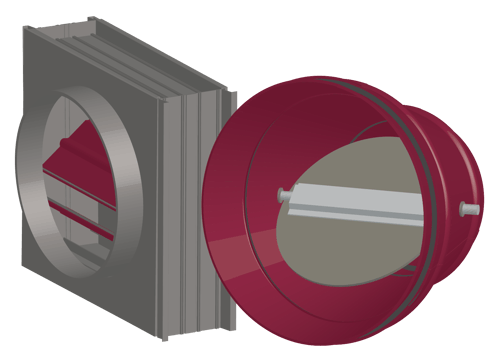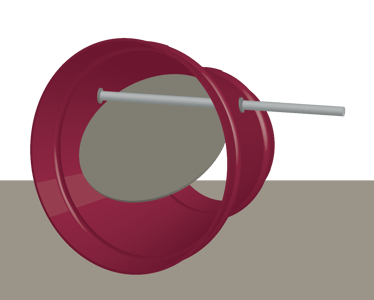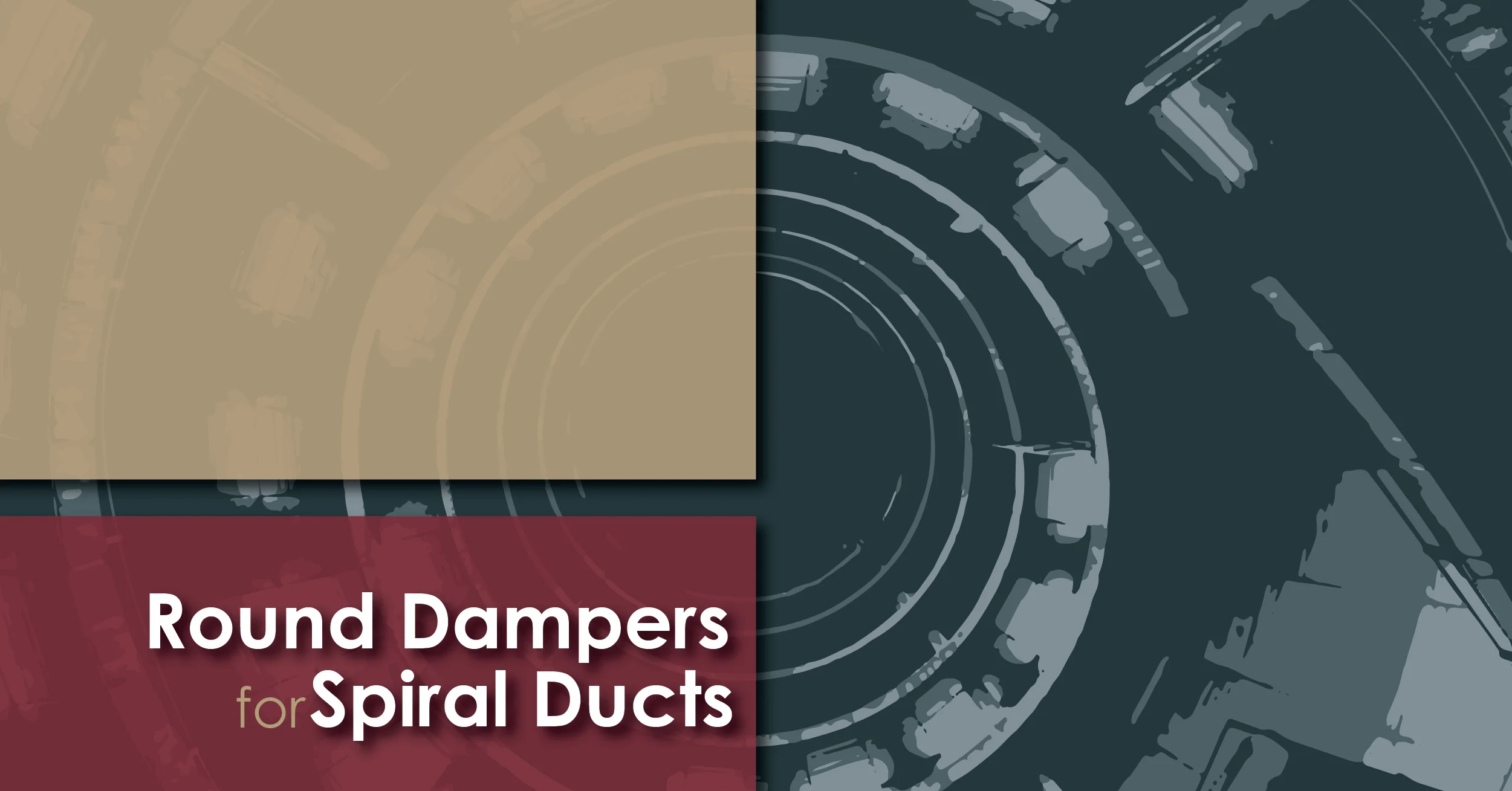In this article, we review the many types of round dampers and how they work. You have options for your spiral ducts!
Spiral Ducts in HVAC
Ducts aren’t always square or rectangular. They can also be round. Round ducts can be circular or oval, forming cylinders that carry airflow across your HVAC system. They are often called spiral ducts, because of the spiral-forming process used to manufacture the ducts. Spiral ducts are common in HVAC design, because they can be easily shaped to bend around obstructions in interior spaces.

Round dampers are built with cylindrical frames that house the damper’s blades. Round dampers can have multiple blades, but they will typically have a single flat blade. The single blade axle will run through the center of the blade. The blade axle will be situated at the center of the damper’s frame. The driving axle will protrude from the frame.
For more on dampers, read these articles on the MCDLG Newsstand:
- Five Types of Dampers and When To Use Them
- Four Ways to Make Efficient Dampers
- The Condenser - A Closer Look at Blade Seals
Round frames will have jambs to conceal the axle. Install an actuator onto the frame to control the rotation of the blade, like a traditional square or rectangular damper. The actuator cannot be mounted inside a truly round damper. Internally mounted actuators would interfere with the single blade. This mount type would not be practical for multi-blade round dampers.
The single round blade is designed to fully cover the opening when rotated to close. Blade seals can be placed in one of two places: on blade stops set within the frame or along the rim of the blade itself. Round dampers can fulfill the role of any other damper in your HVAC system. With a few tweaks in design, round dampers can balance air pressure, direct airflow in one direction, and even contain the spread of smoke through ductwork.
Round Control Dampers
.png?width=500&height=233&name=MCDLG%20Blog%20-%20Round%20Control%20Damper%20(Resize).png)
Round control dampers can be built with multiple blades, like any square damper, but the common design is a single round blade positioned in the center of the frame. The single blade is designed to fully cover the opening of the damper when closed. Round control dampers regulate airflow by opening and closing their blades.
This action works like a square control damper: the blade opens to allow air through and closes to block off the damper. In this way, the damper controls the flow of air through your HVAC system. Tie the blade to an actuator to automate the open and close action. Electric actuators can be connected to a central computer to regulate airflow across the spiral duct system.
Starting a new project and need HVAC dampers? Check out the 517-518 steel control damper from Arrow United Industries. The 517-518 can be equipped with transition collars for a seamless connection with spiral ductwork. Contact Arrow United and let us help with your HVAC requirements!
Round Balance Dampers
.png?width=500&height=222&name=MCDLG%20Blog%20-%20Round%20Balance%20Damper%20(Resize).png)
Round balancing dampers will equalize air pressure between duct sections, thus alleviating issues with air pressure in connected rooms. Operators will adjust the angle of the damper’s round blade and measure the pressure in the connected rooms. Balance dampers are typically equipped with a manual actuator, like a hand quadrant, so that operators can make their adjustments by hand and lock the damper blade when complete.
Balance dampers eliminate drafts and phantom closing doors caused by imbalances in air pressure. Read more about these dampers and how they differ from control dampers with our Newsstand article: Control versus Balance - The Difference Between Dampers.
Round Backdraft Dampers

Backdraft dampers can regulate airflow in one direction without an actuator. The blade axle is located just above the center of the blade, which turns the blade into a flap. While moving in the right direction, air can push the blade open and move through the damper. The blade will stay closed if air is flowing in the opposite direction.
You can mount a counterbalance to the damper’s axle to assist or resist the opening action. Round backdraft dampers are an excellent solution for spiral ducts that will direct airflow in one direction. Read Backdraft Dampers - One-Way Airflow for more on backdraft dampers.
Round Industrial Dampers
.png?width=500&height=201&name=MCDLG%20Blog%20-%20Round%20Industrial%20Damper%20(Resize).png)
Round dampers can be built for industrial settings, such as factories and power plants. These dampers are designed for heavy duty applications, where intense air pressures and velocities are the norm. Round industrial dampers can be built for air control, air pressure balancing, and for one-way backdraft airflow. Their size and weight will require special support and installation procedures.
Consider round industrial dampers for factories with round ductwork. Want to know more about industrial dampers? Read our article on these heavy-duty dampers on the MCDLG Newsstand!
Round Life Safety Dampers
.png?width=500&height=201&name=MCDLG%20Blog%20-%20Round%20Life%20Safety%20Damper%20(Resize).png)
The three primary types of life safety dampers can be round: fire dampers, smoke dampers, combination fire-smoke dampers, and ceiling radiation dampers. Life safety dampers will be required at key points in your HVAC system and spiral ductwork will require these dampers to have round transition collars or a true round shape.
Round curtain fire dampers have a dual-direction curtain blade, which is spring-loaded at the center of the damper. When the fusible link breaks, the curtain unfurls to close off the opening just like a square curtain fire damper.
Round smoke dampers use their single round blades to prevent the passage of smoke through the damper. You can equip your round life safety dampers with the same fire and smoke response systems, such as fusible links and smoke detectors.
Transition or True Round?
You can use a round transition collar on a rectangular damper to install it in spiral ducts. Why use a round damper over a square one? Square and rectangular dampers can connect to round ductwork by using a round transition collar. These connections are made airtight by caulking the spaces between collar and damper.
Transition collars are an effective option, but they place the full body of the damper will be in the air stream. You will also need to maintain the collar over time, to ensure it remains secured to the damper frame. This works for most applications, but the best connection type would be a round damper to a round duct.
Round dampers provide a solid connection to spiral ducts and minimize pressure drop, since the damper frame is out of air stream. Transitions will work, but a true round damper is built for spiral ductwork.
.png?width=500&height=201&name=MCDLG%20Blog%20-%20Round%20vs%20Transition%20(Resize).png)
You have options for your spiral ducts. Round dampers are versatile dampers that can meet any requirement. Consider using a true round damper for your next project.
Is spiral ducting common in your projects? Do you prefer a true round damper over a transition collar? Tell us in the Comments section. We want to hear from you!
Need help with an upcoming project? Contact MCDLG today. We are ready to help you.
.webp?width=91&height=70&name=MCDLG%20Logo%20(Resize).webp)





